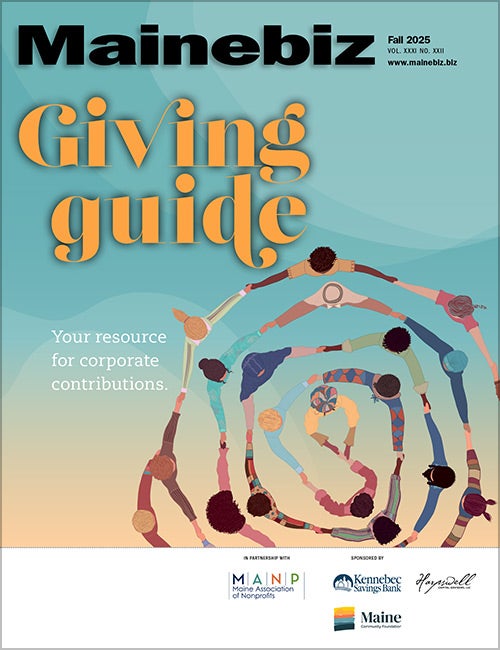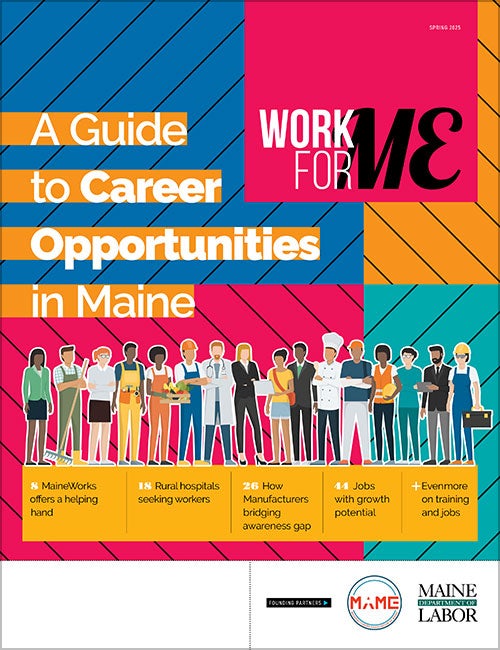Processing Your Payment
Please do not leave this page until complete. This can take a few moments.
- News
-
Editions
View Digital Editions
Biweekly Issues
- December 1, 2025
- Nov. 17, 2025
- November 03, 2025
- October 20, 2025
- October 6, 2025
- September 22, 2025
- + More
Special Editions
- Lists
- Viewpoints
-
Our Events
Event Info
Award Honorees
- Calendar
- Biz Marketplace
Generous perk or employer headache? Maine businesses get ready for paid leave law
 Photo / Tim Greenway
The seasonal hospitality industry is among the industries that is coming to grips with Maine’s new Paid Family and Medical Leave law, as Colby Marvin Bracy at the Nonantum Resort says.
Photo / Tim Greenway
The seasonal hospitality industry is among the industries that is coming to grips with Maine’s new Paid Family and Medical Leave law, as Colby Marvin Bracy at the Nonantum Resort says.
Maine’s Paid Family and Medical Leave law — which takes effect May 1, 2026 — will give employees the option of taking time off to attend to a serious health condition or a family member’s health, the birth of a child or that of a domestic partner, adoption or fostering by the employee or their domestic partner.
It will also cover personal situations like dealing with the transition of a family member’s impending military deployment or to stay safe, or to help a family member stay safe after abuse or violence.
LD 1964 was signed into law in July 2023 as part of the biennial budget, and will afford all of Maine’s 680,000 workers, including those who are self-employed, full- or part-time, 12 weeks of paid time off, at up to 90% of their compensation rate.
The plan will provide the most generous benefits of any state’s plan and is predicted to be one of the more onerous and expensive for employers.
Wage replacement rates for the other 14 states that have enacted some form of paid leave policy generally range from 50% to 80%.
From an employee’s standpoint, it’s a generous perk. But for employers getting prepped for the new law, it has been a major headache.
“The Chamber is very frustrated by how this was implemented. The state has been working extremely hard, but we haven’t always agreed with the outcome of the process,” says Patrick Woodcock, president and CEO of the Maine State Chamber of Commerce, which represents over 5,000 employers.
“It’s such a massive undertaking, and should have included a fiscal note, explaining the additional cost of management and contributions,” he adds. “It’s one of the most significant laws to affect the state economy in 30 years.”
Devil's in the details
One potential weakness in the law that Woodcock sees is in the state’s definition of a family member: “A child, domestic partner’s child, grandchild, domestic partner’s grandchild, parent, domestic partner, sibling or spouse.”
“There are going to be incentives to utilize and to overutilize it,” says Woodcock. “There is going to have to be an ongoing review.”
An authority to oversee the new law is scheduled to meet quarterly and an actuarial study will be due in 2026.
“But ultimately,” Woodcock says, “the entire program really rests in the Maine statute as administered by the Department of Labor.”
Employee eligibility
To be eligible, workers must have earned at least six times the state average weekly wage over a base period. As of July 1, the average wage for 2025 is $1,199 and the maximum weekly benefit is capped at that annual average wage.
But there’s a bit of a loophole in that an employee could be eligible to take leave with a new employer, “on day one,” Woodcock says, if they’ve met the threshold income in a previous job.
“We have been pushing for a change in the legislation that would only allow the employee to be eligible after 120 days at that employer to be eligible for PFML benefits.”
An employee must have put in at least 120 consecutive days in order to have job protection when they take leave. (More details can be viewed on the Maine Department of Labor website.)
“Most small businesses are struggling with how the new law will impact operations on a day-to-day basis,” notes employment attorney Tawny Alvarez, a partner at the Portland law firm Verrill, “especially when we discuss the difference between current obligations and what they can expect if the same circumstances were to happen a year from now once the law is in effect.”
Seasonal challenge
Temporary foreign workers in Maine returning under the H-2B visa program are also eligible for 12 weeks paid time off, Woodcock says, if they meet the work hours eligibility — an allowance that could be especially challenging for businesses that rely on having a reliable workforce during the summer tourist season.
“We have a very tight labor force, and a very seasonal economy,” Woodcock notes. “Losing a critical worker during a business’s prime season is a real pressure point. This is going to be a real test for those that are experiencing workforce pressures to begin with.”
Colby Marvin Bracy, director of people and operations at the Nonantum Resort in Kennebunkport, which has 109 guest rooms, several restaurants, a pool, a riverside marina and events and wedding spaces. The Nonantum employs close to 180; of those, 150 are seasonal workers.
“Paid family leave is an important benefit, but Maine’s new program presents some real challenges for employers like us,” Bracy tells Mainebiz. “Currently, all of our employees — full-time or not — receive eight weeks of paid parental leave at 100% pay, plus an additional four weeks unpaid under the federal Family and Medical Leave Act.
“Under the state plan, some of our employees could actually earn less over twelve weeks of partial pay than they do under our existing policy, while also being required to contribute to the program.”
Funding the program
The legislature allocated a one-time appropriation of $25 million to establish the program, but going forward it’s being funded primarily by payroll taxes.
Starting in January 2025, employers with 15 or more staff have been required to contribute 1% of employee wages to the plan, and they can deduct up to half of that from paychecks.
Companies with fewer than 15 employees must contribute 0.5% of total wages, but can elect to contribute the entire amount from employee paychecks.
Woodcock notes that the new program has already cost the state money when government entities, state universities and community colleges made contributions in the first quarter of 2025 for both employers and employees.
“Employees should have contributed their share,” Woodcock says. “The last thing you want to have is this program putting pressure on an already tenuous fiscal outlook for the state. For a few states, like Washington, this has become an anchor for their state finances.”
Administration of benefits
This past June, the state contracted with the insurer Aflac to administer benefits.
The program has approved 20 insurance policies that can be used by employers in applying for private plans, should they elect not to go with the state benefits plan.
Bracy says the Nonantum hasn’t yet made a firm decision on a provider.
“But I think we are leaning toward going onto the state’s plan since our business and our employees have spent an entire year contributing to this system, and as far as I am aware will not receive reimbursement for that if we opt to use a private plan,” Bracy says.
BIW's approach
Bath Iron Works is one of the state’s largest employers with more than 6,900 employees and a complex existing benefits plan. “We have a great deal of experience in this area but still need to work out many details.
For a small employer the conflict with federal law and overlapping programs could be very challenging,” says David Hench, a spokesman for the shipbuilder. “There are still major issues the legislature has chosen to deflect despite Maine businesses having communicated legitimate concerns.”
How businesses are coping
In response to the new law, Verrill's Alvarez sees many companies becoming leaner.
“They’re attempting to cut costs both from a payroll perspective as well as from an operational perspective in order to counter-balance the rise in costs in other operational areas,” she says.
Alvarez says many businesses have been focusing on other operational concerns — rising costs of supplies and raw goods, tariffs, workforce development, employee benefits and health care costs — and have not been able to give the new plan sufficient time and attention.
“Unfortunately,” she adds, “I believe that this will result in further operational challenges once the law actually takes effect.”
“In becoming ‘leaner’ I’m seeing changes in operational hours and/or in service industries, the services that are provided.”
Mainebiz web partners
Related Content
What effect will the law have on new business formation?

The Giving Guide
The Giving Guide helps nonprofits have the opportunity to showcase and differentiate their organizations so that businesses better understand how they can contribute to a nonprofit’s mission and work.
Learn More
Work for ME
Work for ME is a workforce development tool to help Maine’s employers target Maine’s emerging workforce. Work for ME highlights each industry, its impact on Maine’s economy, the jobs available to entry-level workers, the training and education needed to get a career started.
Learn More
Groundbreaking Maine
Whether you’re a developer, financer, architect, or industry enthusiast, Groundbreaking Maine is crafted to be your go-to source for valuable insights in Maine’s real estate and construction community.
Learn more-
The Giving Guide
The Giving Guide helps nonprofits have the opportunity to showcase and differentiate their organizations so that businesses better understand how they can contribute to a nonprofit’s mission and work.
-
Work for ME
Work for ME is a workforce development tool to help Maine’s employers target Maine’s emerging workforce. Work for ME highlights each industry, its impact on Maine’s economy, the jobs available to entry-level workers, the training and education needed to get a career started.
-
Groundbreaking Maine
Whether you’re a developer, financer, architect, or industry enthusiast, Groundbreaking Maine is crafted to be your go-to source for valuable insights in Maine’s real estate and construction community.
ABOUT
NEW ENGLAND BUSINESS MEDIA SITES
No articles left
Get access now
In order to use this feature, we need some information from you. You can also login or register for a free account.
By clicking submit you are agreeing to our cookie usage and Privacy Policy
Already have an account? Login
Already have an account? Login
Want to create an account? Register
Get access now
In order to use this feature, we need some information from you. You can also login or register for a free account.
By clicking submit you are agreeing to our cookie usage and Privacy Policy
Already have an account? Login
Already have an account? Login
Want to create an account? Register










1 Comments